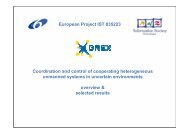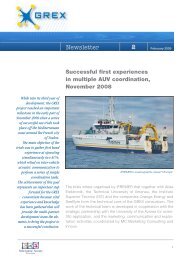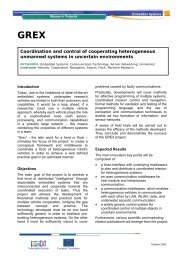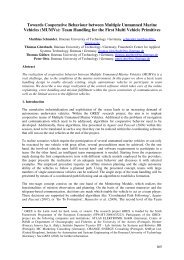The European Project GREX: Coordination and Control of ...
The European Project GREX: Coordination and Control of ...
The European Project GREX: Coordination and Control of ...
You also want an ePaper? Increase the reach of your titles
YUMPU automatically turns print PDFs into web optimized ePapers that Google loves.
Scenario 1 – the quest for hydrothermal vents<br />
Marine scientists (including geologists <strong>and</strong> biologists) have by now gathered considerable<br />
knowledge about deep water hydrothermal vents <strong>and</strong> their intriguing ecosystems<br />
<strong>and</strong> chemosynthetic life forms. <strong>The</strong> vents hold considerable potential for the biotechnological<br />
industry <strong>and</strong> are a window on the evolution <strong>of</strong> life on planet Earth. <strong>The</strong>y are also<br />
spectacular <strong>and</strong> generate widespread public interest.<br />
Besides the well known deepwater vents there are strong indications that hydrothermal<br />
vents exist at 150 m depth, around the D. João de Castro Bank [1], but this has not been<br />
proved yet. <strong>The</strong>re is a need worldwide to develop efficient methodologies to detect intermediate<br />
depth vents because <strong>of</strong> their far reaching implication in the study <strong>of</strong> the biological<br />
responses to an environment wedged between deep <strong>and</strong> shallow waters.<br />
Fig. 1: Scenario drawing: the quest for hydrothermal vents<br />
<strong>The</strong> mission proposed is based on the knowledge that vents produce methane <strong>and</strong> that<br />
methane does not dissolve quickly in the water. This in turn allows for its detection <strong>and</strong><br />
for the measurement <strong>of</strong> the gradient <strong>of</strong> its concentration using methane sensors. <strong>The</strong><br />
two step mission starts with a fast survey <strong>of</strong> a given area using a fleet <strong>of</strong> AUVs equipped<br />
with acoustic sensors. <strong>The</strong> map produced will allow for the examination <strong>of</strong> geological<br />
features (acting as indicators <strong>of</strong> the possible presence <strong>of</strong> vents) that will guide the choice<br />
<strong>of</strong> smaller inspection areas. Once a smaller area is found, a fleet <strong>of</strong> vehicles equipped<br />
with methane sensors can be deployed, as depicted. <strong>The</strong> vehicle baseline configuration<br />
is such that spatial estimates <strong>of</strong> the gradient <strong>of</strong> the methane concentration can be com-<br />
3







